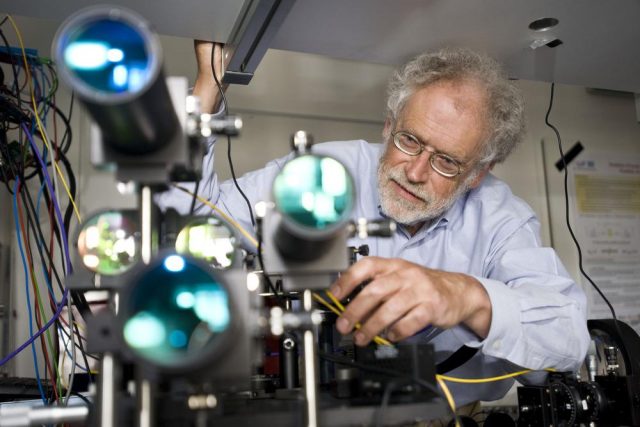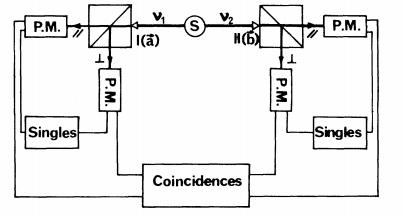The loophole-free quantum entanglement experiment (3): The detection loophole

Let‘s continue with the story of the development of the loophole-free Bell experiment. As we discussed in the first post, it is possible to prove that the universe is either non-real, meaning that the outcomes of some experiments can only be predicted statistically, or it is non-local, meaning that there are signals that propagate faster than light. The key to proving this is Bell’s inequality, which is an inequality based on measuring average values of certain observables of a quantum system. If a function of these average values is higher that a certain threshold the inequality is violated and the system cannot be both real and local. In the second post of the series, we saw some of the first experiments that violated Bell’s inequality. These experiments used cold ions and they have a loophole called the Locality Loophole. The solution to this problem is quite simple from a conceptual point of view. We need two separate labs and we need to perform some measurements fast enough to ensure that no signal travels from one lab to the other one in the time between measures. This is very difficult to do with ions, as they have only short-distance interactions. Because of that, we need to move to a different quantum system, to a system that can travel.
This loophole was already closed by Aspect et al in one of the first papers about Bell violation 1. The system used was one that can travel very easily, light. Photons, the light particle, can be easily produced, manipulated and detected and this makes them a reasonable choice to close the Locality Loophole. In his first experiment, Aspect used two labs separated by 13 meters with measures fast enough to ensure that there was no communication. The degree of freedom analyzed was the linear polarization of two photons.

The problem with photons experiments is that they close the locality loophole, but they open a new one. The new problem comes from the measurement process and it is called the Detection Loophole (some people also called it the “Fair Sampling Loophole”). The problem comes directly from the low efficiency of measuring single photons. Aspect mentioned this problem in his paper and blamed the low-efficiency of single photon detectors [1]. Since then the efficiency of single-photon detectors has risen up to 93% 2 but photons get lost in any case. Photons can travel through air, including very long distances 3, but they are easily absorbed or lost. A typical solution is to use optical fibers to transfer the photons without losses. The problem with fiber is that you need to join it to the detector and in this junction photons can be reflected or absorbed. It is very difficult to have a high efficiency in these experiments and at the end, only a few pairs of photons are detected and used to compute the average numbers required by Bell inequalities.
Why is this a problem? As we have said, Bell’s inequality is statistical. It is based on average numbers. If we take into account only some of the events of the experiment it is possible that all the unmeasured events ‘conspire’ against us. Imagine that there are unknown states of the photon, that are easily lost or that cannot be detected, and they have specific properties that reduce the value of the inequality violation. If you cannot detect them you cannot assure that the violation you observe is legitimate. You need to introduce a new assumption to your experiment, meaning that you need to assume that the undetected event has the same statistic that the detected ones. This is called the Fair Sampling Assumption. It has been calculated that you can get rid of this assumption only if you can detect more than 67% of the events (this value depends on the specific choice of Bell’s inequality).
The detection loophole does not affect ions experiments because the measures in ions have a high efficiency, but the Locality Loophole affects ions. It is quite hard to close both loopholes at the same time. Zeilinger and his group already closed the Measurement Loophole for photons in 20134. Unfortunately, in this experiment the source and detectors should be placed very close to each other and the Locality Loophole takes place again. Closing both the Locality and Detection loopholes is a formidable task and there is still one more loophole to worry about!
References
- A. Aspect, P. Grangier, and G. Roger. (1982) Experimental Realization of Einstein-Podolsky-Rosen-Bohm Gedankenexperiment: A New Violation of Bell’s Inequalities. Phys. Rev. Lett. 49, 91. ↩
- R. Hadfield. (2009) Single-photon detectors for optical quantum information applications. Nature Photonics 3, 696 (2009). ↩
- S. Nauerth, et al. (2013) Air-to-ground quantum communication. Nature Photonics 7, 382. DOI:10.1038/nphoton.2013.46 ↩
- M. Giustina et al (2013) Bell violation using entangled photons without the fair-sampling assumption. Nature 497, 227 (2013). DOI:10.1038/nature12012 ↩